Growth hormone-releasing hormone analogues produce metabolic changes at varying rates, depending on the body system being measured. Fat reduction happens on one timeline. Lipid changes follow another schedule. Glucose metabolism shifts occur at yet different intervals. Clinical trials typically run for 6 to 12 months because some benefits may take several months to develop fully. Analysts examine timing patterns of measurable growth, and within these moments, some participants preferred to bluumpeptides, which correlated positively with encouraging investigational results.
Body fat reduction timeline
Tesamorelin targets visceral fat stored deep in the abdomen. CT scans or MRI imaging shows this fat decreasing after 8 to 12 weeks of daily injections. Some people respond more quickly, showing changes by week 6. Most participants show a clear reduction by week 10. Visceral fat area drops 10 to 15 percent after 3 months of treatment. Regular fat under the skin remains relatively unchanged during this period. The peptide acts selectively on deep abdominal deposits. Body weight stays relatively stable because muscle tissue increases while fat decreases. These opposing changes balance each other on the scale.
Waist measurements typically shrink by 2 to 4 centimetres by week 12 in people who respond to treatment. DEXA scans detect trunk fat loss starting around week 8. The reduction becomes more obvious through week 26. Imaging studies conducted on a weekly basis show that fat loss occurs gradually rather than suddenly. The first month produces little visible change. Weeks 6 through 12 show the fastest reduction rate. Beyond 12 weeks, fat continues to decrease, but more slowly, through month 6.
Lipid changes develop gradually
Triglyceride levels respond fairly quickly compared to other metabolic markers. Blood tests show decreases within 4 to 8 weeks. Cholesterol takes longer to shift, typically requiring 12 to 16 weeks for meaningful changes to appear. Fasting triglyceride levels drop 15 to 25 percent by week 8 in published studies. LDL cholesterol barely changes in the first 2 months. Modest reductions of 5 to 10 percent show up around month 4. HDL cholesterol levels remain mostly unchanged throughout treatment in most studies.
Non-HDL cholesterol decreases along with triglycerides, becoming noticeable around week 10. Apolipoprotein B levels decline gradually, with a measurable difference evident by week 16. Individual responses vary widely. Some participants show major triglyceride drops within 4 weeks. Others require 3 months of steady dosing before lipid improvements become evident. Starting lipid levels affect response speed. Higher baseline triglycerides often drop faster in percentage terms.
Glucose metabolism improvements
Insulin sensitivity gets better over extended treatment periods. Glucose tolerance tests reveal changes later than those in body composition or lipid levels. Most studies document improvements in glucose levels between weeks 12 and 24. Fasting glucose shows little change in the first 8 weeks. Levels then gradually decline in participants who started with elevated readings. Insulin sensitivity, as measured by standard calculations, improves after 12 to 16 weeks of daily dosing. Glucose tolerance tests demonstrate better sugar handling after meals once 20 weeks of treatment have passed. This finding primarily applies to individuals with metabolic syndrome. This timing matches visceral fat reduction. This usually resolves by week 4 to 6. Insulin sensitivity improvements then emerge as visceral fat shrinks.
Studies running longer than 6 months show that benefits continue to accumulate. Visceral fat reduction reaches a plateau around months 9 to 12. Lipid improvement levels off after 6 months. Glucose metabolism continues to improve through 12 months in some trials, although most changes occur within the first 6 months.

